锂离子电池负极材料银纳米线的锂化机制
2024-07-08刘海辉张欣欣
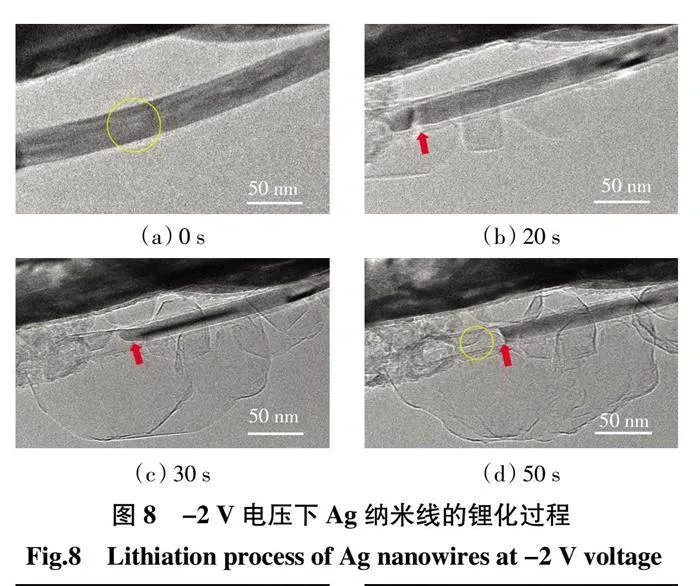

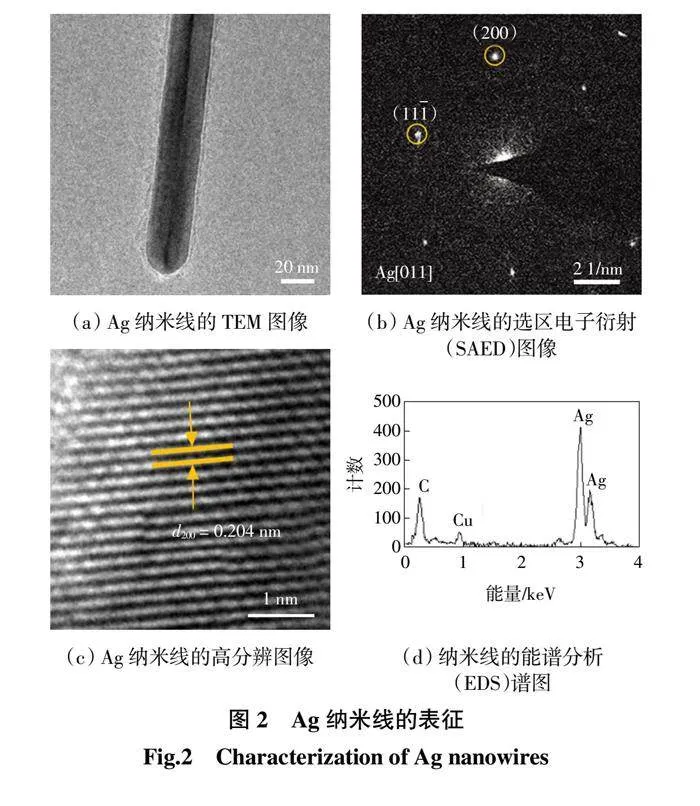

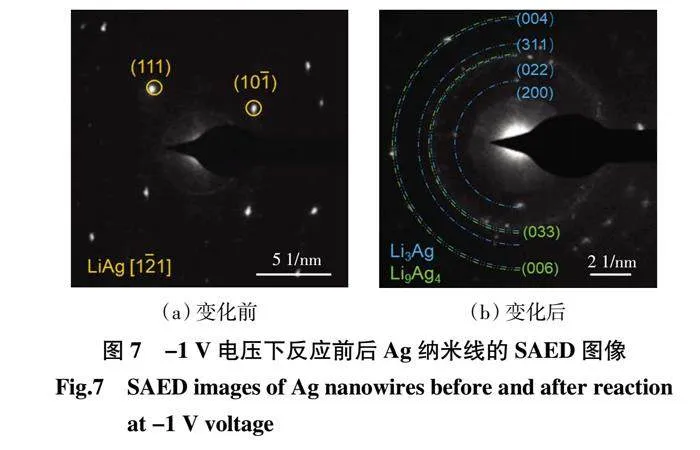
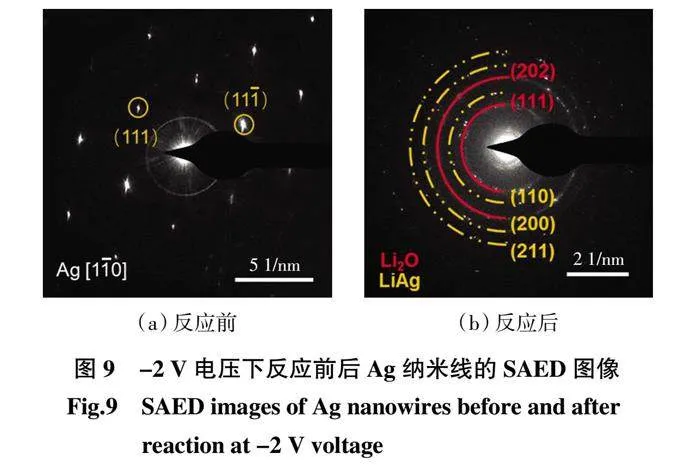
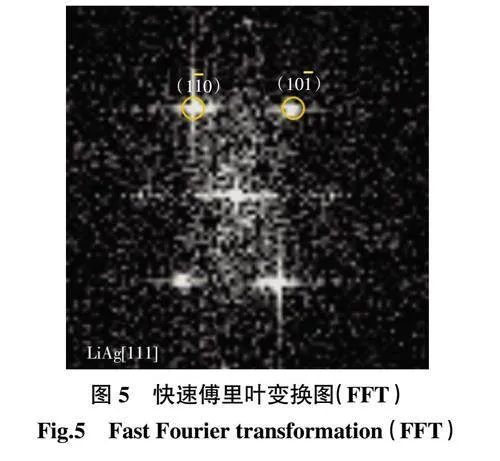
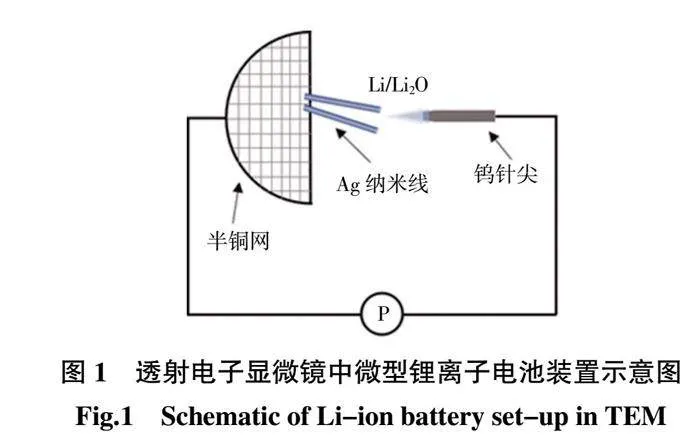
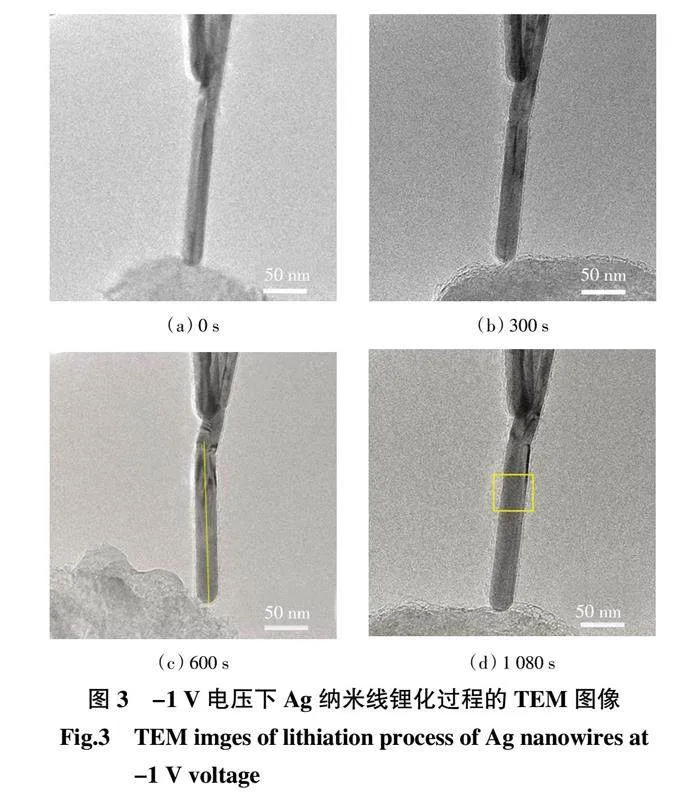
摘 " "要: 为了探究银纳米线在不同工作电压下的锂化机制,借助原位透射电子显微镜的高分辨技术和电子衍射技术,研究了在不同的工作电压条件下,银纳米线在锂化过程中的相变过程和形貌变化。结果表明:金属银用于电池负极材料时,其工作电压对电极材料的活性有较大影响;银在低工作电压下的储锂量大,电极材料不易失效;当工作电压为-1 V时,Ag纳米线在储存锂离子过程中会先变成LiAg相,无明显体积形变;后续随着锂化时间增加,LixAg合金中x gt; 1时,纳米线粉碎化,生成Li3Ag、Li9Ag4相;当外加的电压为-2 V时,锂离子会快速在纳米线表面运输并与Ag发生反应,导致纳米线破碎。
关键词: 锂离子电池;负极材料;Ag 纳米线;锂化反应机制;原位透射电镜
中图分类号: TBQ152;TM911.3 " " " " " " 文献标志码: A " " " " " " " "文章编号: "1671-024X(2024)02-0055-05
Lithiation mechanism of silver nanowires as negative electrode materials for
lithium-ion batteries
LIU Haihui1,2,3, ZHANG Xinxin1,2,3
(1. School of Material Science and Engineering, Tiangong University, Tianjin 300387, China; 2. State Key Laboratory of Separation Membranes and Membrane Processes, Tiangong University, Tianjin 300387, China; 3. Key Laboratory of Ad-vanced Fiber and Energy Storage Technology, Tiangong University, Tianjin 300387, China)
Abstract: In order to explore the lithiation mechanism of silver nanowires at different working voltages, with the help of high-resolution technique and electron diffraction technique of in situ transmission electron microscopy, the phase transition process and morphology transition of silver nanowires during lithiation under different working voltages were studied. The results show that when metallic silver is used as the negative electrode material of the battery, its working voltage has a great influence on the activity of the electrode material; silver has a large amount of lithium storage at low operating voltage, and the electrode material is not easy to fail. When the operating voltage is -1 V, the Ag nanowires first form LiAg phase during the process of storing lithium ions, and there is no obvious volume deformation. With the subsequent increase of lithiation time, when the x in LixAg alloy exceeds 1, the nanowires are pulverized to form Li3Ag and Li9Ag "phases; when the applied voltage is -2 V, lithium ions are rapidly transported on the surface of nanowires and react with Ag, and leading to the "fragmentation of nanowires.
Key words: lithium-ion battery; negative electrode material; Ag nanowires; lithiation reaction mechanism; in situ transmission electron microscopy
能源需求的增加以及绿色可持续发展的理念使得清洁可再生能源得到大力发展,其中,锂离子电池在为电子产品供电方面发挥了关键作用[1-3]。为增加负极材料的储能效率,获得容量高、安全性能优异的电极材料,需要对负极材料进行创新性研究。在负极材料中,合金型负极在与锂离子形成合金相时可以达到高能量容量和安全性好等效果,成为有前途的锂离子电池负极材料[4-6]。在电极材料的研究中,纳米材料中的离子迁移过程与宏观电化学性能联系密切;材料在电化学过程中储存锂离子的能力决定电池的比容量;材料内部结构在离子嵌入和脱出过程中的稳定性与电池的安全稳定性密切相关;离子的迁移速率影响了电池的速率性能。
银(Ag)金属具有高的电导率和热导率等优点,在低工作电压时与锂(Li)发生合金化反应,可以形成广泛的固溶体相和多种中间相,储锂量最高可以形成Li12Ag相[7],展示出高的比容量。Ag既可以实现稳定的电化学过程,也可以改善界面性能,已被广泛应用于锂离子电池中作为负极材料、导电剂以及与其他材料复合作为负极材料[8-13]。研究者采用了多种途径探究银锂合金相的相图[14- 15],发现在LixAg (x = 4.7~20) 合金中存在β、γ1、γ2、γ3等多种相。进一步探究电极材料纳米化对电池性能的影响,实验证明当Ag的尺寸达到纳米级时,电池的首次比容量可达到473 mA·h/g,提高了电池的比容量和循环效率等性能[16]。因此,银用于锂离子电池负极材料具有广阔的发展前景。
透射电子显微镜可以同时提供电极材料在电化学过程中的形貌变化和相组成变化等信息,成为研究者原位探测电极材料在电化学过程中变化的有力工具。为实时探究电极材料在电化学过程中的形貌变化和成分变化等信息,本文借助透射电子显微镜(transmission electron microscope, TEM)独有的高分辨技术和电子衍射(electron diffraction, ED)技术,实现对电极材料在锂化过程中变化的实时监测[17-20]。在TEM中搭建微型固态电池,探究了Ag电极材料在不同工作电压下的锂化机制。通过外界装置对电极材料施加电场,促进锂离子向电极材料内部运输,借助高分辨技术和电子衍射技术,观察了Ag纳米线在嵌锂过程中的结构变化和相变过程,以期为提高Ag基电极材料的循环稳定性提供指导。
1 实验部分
1.1 材料与仪器
材料:Ag纳米线,直径20~50 nm,纯度大于99.5%,上海阿拉丁生化科技股份有限公司产品。
仪器:配备OneView IS(Gatan)相机的FEI Tecnai F20型高分辨场发射透射电子显微镜,美国FEI公司产品。
1.2 原位电化学锂化实验
在 TEM 中组装的 Li-Ag 电池的示意图如图 1 所示。
使用 TEM-STM 原位样品架在充满氩气的手套箱中组装固态电池装置。使用半铜网蘸取Ag纳米线为一段电极,把前端沾有锂金属的钨针尖用作对电极。将装置移入TEM室时,尖端暴露在空气中几秒钟,锂表面会自然形成氧化层作为固体电解质。为了进行电化学锂化过程,实验过程中操纵尖端与纳米线连接以形成回路,向尖端施加电压以促进锂离子的迁移,在TEM中对这一实验过程进行实时监测。
2 结果与讨论
2.1 Ag纳米线表征
Ag纳米线的形貌和相组成如图2所示。
由图2(a)可以得知,Ag纳米线的直径为25 nm。由图2(b)纳米线的选区电子衍射(selected area ele-ctron diffraction,SAED)图像可知,图中没有多余衍射斑点存在,表明纳米线的结晶性好,对应的晶向为[011]。由图2(c)纳米线的高分辨透射图像(high resolution transmission electron microscope,HRTEM)可知,衍射条纹属于Ag(200)晶面的有序晶格条纹。由图2(d)EDS图谱可知,Cu元素和C元素的产生是由于铜网微栅的散射导致的,与纳米线本身的成分组成无关。综上所述,本实验使用的Ag纳米线直径分布在20~40 nm之间,结晶性较好,相组成为单一Ag物质。
2.2 Ag纳米线在锂化过程中的变化分析
为了探测Ag电极材料在不同工作电压下的锂化机制和形貌变化,实验通过控制外加电场为变量,在TEM中实时记录了这一锂化流程。
2.2.1 -1 V工作电压下的变化
图3为在-1 V的工作电压下,锂离子嵌入过程中Ag纳米线形貌变化的TEM图。
移动针尖使锂离子与Ag纳米线接触后,通过外加电场可以促进锂离子向电极材料内部迁移。由图3可以看出纳米线的形貌变化,直至反应时间为1 080 s时,其直径没有发生变化,此时电极材料的结构稳定,有利于在实际的电化学应用中提高电极材料的活性利用率。
对反应后的纳米线成分进行探究。图4为锂化后纳米线的HRTEM图像,对应图3(d)中黄色方框标注的区域。图5为图4对应的快速傅里叶变化图(FFT)。由图4和图5可以判断得出反应后的物质为LiAg相,显示了LiAg(110)晶向有序的晶格条纹,测得此时的晶格间距为0.224 nm。
文献[7]研究表明,Ag在进行储锂时容量最高可以形成Li12Ag相,为进一步探测在低电压下Ag纳米线的储锂能力,对另一根纳米线同样施加-1 V电压,电化学过程中的形貌变化如图6所示。图7 为形貌变化前后纳米线的SAED图像,分别对应图6(b)、图6(d)中黄色圆圈标注的区域。
由图6可知,延长反应时间至4 600 s时,纳米线的形貌始终没有发生明显变化,此时电极材料的结构稳定,通过SAED图像判断此时的物相为[121]晶面的LiAg相(图7(a))。随着锂化深度的增加,当锂化反应进行到第4 740 s后,纳米线结构开始出现破碎的现象,纳米线逐渐颗粒化并导致其直径变小,反应路径如图6(d)中黄色箭头所示。通过对反应后的样品(图6(d)中黄色圆圈所示区域物质)进行物相分析,从其SAED图像(图7(b))中的多晶衍射圆环判断得知,此时的物相为Li3Ag、Li9Ag4多晶相。由此说明,在低工作电压下,Ag和Li可以形成合金相,对于直径为30 nm左右的Ag纳米线,初始时Ag与Li形成LiAg合金相,电极材料的结构稳定,而当合金相中的x gt; 1时,由于晶格膨胀等原因,会引发纳米线颗粒化,导致原有的结构坍塌。
2.2.2 -2 V工作电压下的变化
为探究Ag在不同工作电压下的锂化机理,对Ag纳米线两端施加了-2 V的电压,嵌锂过程中的形貌变化过程如图8所示。图9 为反应前后纳米线的SAED图像,分别对应图8(a)、图8(d)中黄色圆圈标注的区域。
由图8可知,当工作电压为-2 V时,锂离子会在纳米线表面快速迁移,在纳米线中可以看到明显反应路径,如图8中红色箭头标注所示,此时的锂化速率远大于工作电压为-1 V时的锂化速率。对比反应前后纳米线的SAED图像(图9),可以判断反应时Ag与Li快速反应直接生成LiAg颗粒,图9(b)中的衍射环也显示此时图8(d)的黄色圆圈中的物相为LiAg和包覆在纳米线表面的Li2O。这是由于LiAg合金中的Li-Ag键在O2的环境下容易形成Li2O,这一实验现象曾在相似的条件下被报道过[21]。
3 结 论
本文探究了Ag纳米线在不同工作电压下的锂化机制,借助透射电子显微镜,在电镜中构建小型固态电池,使得锂与直径范围在20~40 nm内的Ag纳米线接触,对其施加不同的工作电压,结合TEM中的高分辨技术和SAED技术,一方面观察纳米线在锂化过程中的形貌变化,另一方面分析处理过程中纳米线的物相变化。结果表明:
(1) 当工作电压为-1 V时,Ag纳米线会与Li形成LiAg合金相,此时材料的直径没有明显的变化;随着储存锂离子量的增加,当LixAg合金中的x gt; 1时,纳米线由于颗粒化会发生破碎,直径变小,锂化后纳米线的组成为Li3Ag、Li9Ag4多晶相。
(2) 当工作电压为-2 V时,Ag纳米线会快速与Li反应生成LiAg颗粒,之后又会被O2分解为Li2O和Ag。
这些原位观察为固态电化学合金化动力学提供了直接证据和见解,对如何提高Ag基电极材料循环稳定性具有一定指导意义。
参考文献:
[1] " "雷中祥,解刚,陈泽钧. 锂离子电池用三维多孔VxOy@Cu复合负极材料的制备及其储能性能[J]. 天津工业大学学报,2021,40(6):47-51.
LEI Z X, XIE G, CHEN Z J. Preparation and energy storage performance of 3D porous VxOy@Cu composite anode material for lithium-ion batteries[J]. Journal of Tiangong University,2021,40(6):47-51(in Chinese).
[2] " "TARASCON J M, ARMAND M. Issues and challenges facing rechargeable lithium batteries[J]. Nature, 2001, 414(6861): 359-367.
[3] " "赵永男,郭敏,高海燕,等.低含量锰掺杂Li2FeSiO4/C作为锂离子电池正极材料的电化学性能[J].天津工业大学学报,2020,39(6):53-60.
ZHAO Y N, GUO M, GAO H Y, et al. Electrochemical performance of low content Mn-doped Li2FeSiO4/C cathode materials for lithium-ion batteries[J]. Journal of Tiangong University,2020,39(6):53-60(in Chinese).
[4] " "ZHANG W J. A review of the electrochemical performance of alloy anodes for lithium-ion batteries[J]. Journal of Power Sour-ces, 2011, 196(1): 13-24.
[5] " "ZHANG W J. Lithium insertion/extraction mechanism in alloy anodes for lithium-ion batteries[J]. Journal of Power Sources, 2011, 196(3): 877-885.
[6] " "OBROVAC M N, CHEVRIER V L. Alloy negative electrodes for Li-ion batteries[J]. Chemical Reviews, 2014, 114(23): 11444-11502.
[7] " "TAILLADES G, SARRADIN J. Silver: High performance an-ode for thin film lithium ion batteries[J]. Journal of Power Sour-ces, 2004, 125(2): 199-205.
[8] " "BRAGA M H, DEBSKI A, TERLICKA S, et al. Experimental and ab initio study of the Ag-Li system for energy storage and high-temperature solders[J]. Journal of Alloys and Compounds, 2020, 817: 152811.
[9] " "PHATTHARASUPAKUN N, WUTTHIPROM J, DUANGDAN
GCHOTE S, et al. A 3D free-standing lithiophilic silver nanowire aerogel for lithium metal batteries without lithium dendrites and volume expansion: In operando X-ray diffrac-tion[J]. Chemical Communications, 2019, 55(40): 5689-5692.
[10] "GAO J, YANG L C, FU L J, et al. Novel composite anode materials of Ag and polymeric carbon for lithium ion batteries[J]. Polymers for Advanced Technologies, 2006, 17(7/8): 587-590.
[11] "RONNEBRO E, YIN J T, KITANO A, et al. Reaction mecha-nism of a Ag36.4Sb15.6Sn48 nanocomposite electrode for advanced Li-ion batteries[J]. Journal of the Electrochemical Society, 2005, 152(1): A152-A157.
[12] "DU F H, WANG K X, FU W, et al. A graphene-wrapped sil-ver-porous silicon composite with enhanced electrochemical performance for lithium-ion batteries[J]. Journal of Materials Chemistry A, 2013, 1(43): 13648-13654.
[13] "LI S, HUANG J G. A nanofibrous silver-nanoparticle/titania/carbon composite as an anode material for lithium ion batteries[J]. Journal of Materials Chemistry A, 2015,3(8): 4354-4360.
[14] "ZHANG S M, YANG G J, LIU Z P, et al. Phase diagram dete-rmined lithium plating/stripping behaviors on lithiophilic subs-trates[J]. ACS Energy Letters, 2021, 6(11): 4118-4126.
[15] "JIN S, YE Y D, NIU Y J, et al. Solid-solution-based metal alloy phase for highly reversible lithium metal anode[J]. Journal of the American Chemical Society, 2020, 142(19): 8818-8826.
[16] "PARK C M, JUNG H, SOHN H J. Electrochemical behaviors and reaction mechanism of nanosilver with lithium[J]. Electro-chemical and Solid State Letters, 2009, 12(9): A171-A175.
[17] "皇甫磊磊, 翟阿敏, 田鹤, 等. 碳纳米纤维储钠机制的原位透射电镜研究[J]. 电子显微学报, 2019, 38(6): 593-599.
HUANGFU L L, ZHAI A M, TIAN H, et al. In situ TEM study on mechanism of sodium storage in carbon nanofibers[J]. Journal of Chinese Electron Microscopy Society, 2019,38(6): 593-599(in Chinese).
[18] "CHEN S L, YANG C, SHAO R W, et al. Direct observation of Li migration into V5S8: Order to antisite disorder intercalation followed by the topotactic-based conversion reaction[J]. ACS Applied Materials amp; Interfaces, 2020,12(32): 36320-36328.
[19] "HAN B, CHEN S L, ZOU J, et al. Tracking sodium migration in TiS2 using in situ TEM[J]. Nanoscale, 2019, 11(15): 7474-7480.
[20] "柯承志, 肖本胜, 李苗, 等. 电极材料储锂行为及其机制的原位透射电镜研究进展[J]. 储能科学与技术, 2021, 10(4): 1219-1236.
KE C Z, XIAO B S, LI M, et al. Research progress in under-standing of lithium storage behavior and reaction mechanism of electrode materials through in situ transmission electron micro-scopy[J]. Energy Storage Science and Technology, 2021, 10(4): 1219-1236(in Chinese).
[21] "XU L, HONG Y R, WANG J W, et al. In situ monitoring na-noscale solid-state phase transformation of Ag nanowire during electrochemical reaction[J]. Scripta Materialia, 2021, 199: 113835.
本文引文格式:
刘海辉,张欣欣. 锂离子电池负极材料银纳米线的锂化机制[J]. 天津工业大学学报,2024, 43(2): 55-59.
LIU H H, ZHANG X X. Lithiation mechanism of silver nanowires as negative electrode materials for lithium-ion batteries[J]. Journal of Tiangong University, 2024, 43(2): 55-59(in Chinese).
